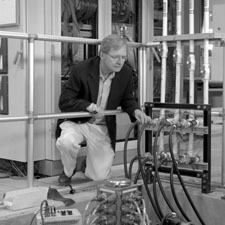 |

Digging In ToAce The Test by Mike Perricone Digging a hole five feet across and 21 feet deep might sound like a straightforward civil construction task, but it became one of the biggest adventures in constructing the Vertical Magnet Test Facility housed in Fermilab’s Industrial Center complex. "It was a real mess, because this area is basically built on a swamp," said Mike Lamm of the Technical Division’s Development and Test Department, who won a Fermilab Employee Recognition Award along with Tom Peterson (see the accompanying story) for bringing the VMTF from concept to completion. The design work began in early 1994, with the first tests of magnet models run in late 1996. The VMTF was built to test superconducting electromagnets fabricated at Fermilab for the Large Hadron Collider project at CERN, the European particle physics laboratory in Switzerland, but its use will extend to future magnet development at Fermilab. But first they had to dig the hole. The plan was to insert a steel sleeve to hold back the walls of earth as the digging progressed. When the digging was completed, concrete would be poured for the permanent support, with the steel sleeve extracted. The steel sleeve couldn’t be left in place, because as a magnetic material, it would disrupt the intricate field measurements of the three-ton superconducting magnets to be tested in the giant Thermos bottle that would eventually fill the hole. The trick involved precise timing: if the steel sleeve were removed too soon, the walls would collapse; if it were left too long, it would bond to the concrete, making the excavation useless. When the time came to remove the sleeve, it wouldn’t budge, and only frantic efforts by the contractors saved the project. "I was ready to get on the phone and call for every earth-moving vehicle on the site to converge on Industrial Building 1 and lift this thing out," Lamm said. "But fortunately, (the contractors) got it out." The framework of the VMTF also extends as high as the 25-foot ceiling of the Industrial Building. A 10-ton crane resides on a track near the ceiling ("We had to shop around to find one that tucked up to the ceiling as close as possible," Lamm explained). The crane reaches down to lift an assembly that includes a three-ton magnet attached on end to a fiberglass-epoxy connecting plate and sealer called a "lambda plate," which is in turn connected to a stainless steel lid called the "top hat." An excellent thermal insulator, stainless steel is also non-magnetic. The top hat serves as the lid of the sunken thermos bottle (actually a Dewar flask, named for inventor Sir James Dewar), a double-walled stainless steel vessel with vacuum insulation, which holds liquid helium. The lambda plate seals off the lower chamber of the vessel, where the liquid helium is further cooled to just above absolute zero (1.9 degrees Kelvin). The crane lowers the assembly and dips the magnet into the dewar, the magnet is ramped up, and the magnetic field is measured for strength and accuracy under superconducting conditions. A spinning probe is inserted through the top hat, the lambda plate and the bore of the magnet to measure the field incrementally from end to end. The testing instrumentation is installed in electronic modules, and tests can be changed easily by substituting different modules. "This was a fantastically well-done and well-organized job," said Peter Limon, head of the Technical Division. "It’s a key element in the future of Fermilab, because it permits us to design and build many different kinds of magnets." |
| last modified 6/18/1999 email Fermilab |
FRLsDFx9eyfrPXgV